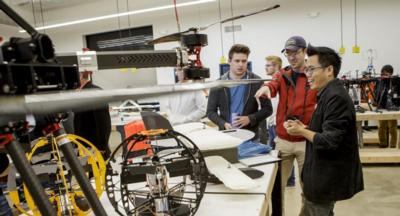ATLAS Is Designed To Carry A Payload Specific To The Mission
The aftermath of the Oklahoma City bombing in 1995 that left 168 people dead sparked the work being done now by Oklahoma State University’s (OSU) Unmanned Systems Research Institute to help first responders. 25 years ago, there was no technology available that could help rescuers locate victims without risking their own lives to climb throughout what was left of the Murrah Building.

With this in mind, the now deceased Jon Hansen of the Oklahoma City Fire Department said that first responders needed a better way to conduct searches of rooms and communicate with the injured without having rescuers climbing through an unstable structure.
This led Dr. Ben Loh, USRI graduate and research engineer, to creating a drone encased in a protective cage called All Terrain Land and Air Sphere (ATLAS). OSU notes that typical drones have exposed propellers and require a coordinated landing. If the drone turns over, it can’t right itself. “With something like the Murrah bombing scene, most exposed propeller platforms like a quadcopter can easily get caught by the debris or dangling wires in the building,” Loh explains.
“A quadcopter without a prop guard could accidentally hit an obstacle and flip over. This could mean the end of the mission since it cannot recover to flight.”
Thanks to ATLAS’ spherical cage, propellers are protected from debris, and people are protected from the propellers.
“The spherical frame can endure an uncoordinated landing. The cage allows … ATLAS to roll away from obstacles and recover to flight,” Loh says.
One of ATLAS’ key features is its ability to land in uneven terrain. If the propellers are stopped, rescuers have a better chance of communicating with victims.
“Noise from the propellers is always an issue if using a microphone to pick up the victim's voice at a disaster area,” Loh says. “One way to overcome that is to land the vehicle to stop the propeller.”
To improve the drone’s battery life, Loh has been working on reducing the weight and size from 17 inches to 13 inches. While optimized for indoor operations, the drone can also be used during outdoor missions as well.
“The research is ongoing to make ATLAS more efficient as battery (power) remains the limitation for most drones today,” Loh says.
ATLAS is designed to carry a payload specific to the mission, such as cameras, CO2 sensors and lidar. Loh has also created an affordable version of the drone for STEM teachers in elementary and secondary education that has a foam-board cage.
To get feedback on the project, Loh has met with fire departments, emergency managers and other potential customers. OSU says that the design is ready for testing at the next natural or man-made disaster.
“The ability to design and develop these systems to not only assist first responders, but potentially save lives, really targets OSU’s mission as a land-grant university,” says Dr. Jamey Jacob, director of the Unmanned Systems Research Institute. “What serves the public good more than helping those who help others?”
 ANN's Daily Aero-Term (04.26.24): DETRESFA (Distress Phrase)
ANN's Daily Aero-Term (04.26.24): DETRESFA (Distress Phrase) Aero-News: Quote of the Day (04.26.24)
Aero-News: Quote of the Day (04.26.24) ANN's Daily Aero-Term (04.27.24): Direct
ANN's Daily Aero-Term (04.27.24): Direct ANN's Daily Aero-Linx (04.27.24)
ANN's Daily Aero-Linx (04.27.24) Aero-News: Quote of the Day (04.27.24)
Aero-News: Quote of the Day (04.27.24)



